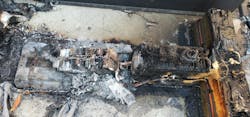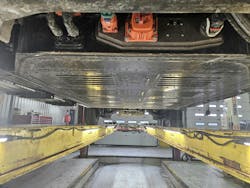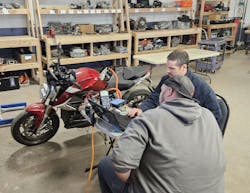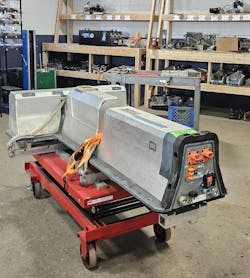Shop fire risks with EVs and gas-powered engines
If you have worked in this industry a long time, you may have experienced a backfire and then used an oily rag to put out a carburetor fire. I have seen the burned paint on the hood of a '60s V8 muscle car. If a home mechanic changed an external fuel filter and the copper gaskets were not replaced, the “squirt gun” effect of fuel spraying onto the hot exhaust manifold sure made a hot mess. The good old days may have just been old and not as good as our memories trick us into nostalgia.
It is 2025. Let us take a fact-based view of a thermal event, as my engineering friends like to call them. This is a subject that many people, including my younger self, would make jokes about without understanding the aftermath of a simple mistake that led to serious consequences.
Here are the facts as best I could gather. Electric vehicles (EVs) are less likely to catch on fire than gasoline-powered vehicles. Some studies suggest that the risk of an EV fire is 20 times lower than that of a gasoline-powered car. A 2022 study by the Swedish Contingencies Agency found that gasoline and diesel vehicles produced 68 fires per 100,000 vehicles, compared to 3.8 fires per 100,000 for EVs. A report by the UK's Guardian newspaper found that EVs are less likely to catch fire than gas-powered cars, but that study did not offer much in the way of the analytical process. A 2020 Tesla internal report suggested there was one Tesla fire for every 205 million miles traveled, but that was not an independent view.
If there is an EV fire in a repair shop, that is a major news story. As a member of the International Motor Press Association (IMPA), I stay up to date with that type of news. The number of EV fires in U.S. shops may total five since 2010, when Nissan Leaf and Chevy Volt went on sale. So why all the buzz about EVs burning down your shop? Consider this news story from a Pittsburgh, Pa. news outlet on Oct. 28, 2023:
“An investigation is underway after a vehicle repair and service facility caught fire on Friday morning. According to Pittsburgh Public Safety, around 6:15 a.m. the Pittsburgh Bureau of Fire was called to the 800 block of Gross Street for reports of a fire. Once they arrived, they found a vehicle inside the repair and service shop on fire and it took nearly 45 minutes for crews to fully extinguish the fire. Due to the nature of the fire, crews remained on scene for nearly seven hours to make sure the vehicle did not reignite. While an investigation is underway, early signs point to an electric vehicle lithium-ion battery having ignited.”
According to my research, the 800 block of Gross Street is a few blocks past a residential street that dead ends under an elevated expressway. That last few blocks are old factory buildings. The shops looked to be unmarked with no signage and graffiti on the exterior. This shop does not represent the best of us.
Although exact numbers are difficult to pinpoint due to the varied nature of shop operations and reporting practices, data from the National Fire Protection Association (NFPA) indicates that fire departments respond to an average of around 4,150 fires at service stations or gas station properties per year, which includes repair shops that might be located on these properties. The total number of motor vehicle repair shops is about 180,000 in the USA.
ACDC has had a long history with hybrid and plug in cars and trucks. Ed Rueda owned a shop in Petaluma, California named Hybrid Haven. In my travels I ended up teaching a hybrid and EV class at his shop about the year 2010 or 2011 on a Saturday. I got to know Ed well as the next day we went to church together. Over the years we would visit by phone or get together in Las Vegas for the November “Industry Week” event. As a BMW racer, Ed met Roger Rodas, another BMW race car driver at the race tracks in California. With that shared interest, Ed got to know Roger. At their next visit at the track, Roger told Ed he was in business with Paul Walker, who you know from the Fast and the Furious movies, and they owned a high-end repair shop called Always Evolving. They employed Umesh Patel as their head technician. In the summer of 2013, Umesh took the ACDC class called “Up Your Voltage” to prepare for a franchise called Hybrid Haven, that included Ed, Roger, Paul, Umesh, and myself. There was one other person I met later who was hired to procure the parts needed to supply the Hybrid Haven shops ready to launch all across the USA. This team was ready to put this plan into action. On Nov. 30, 2013, Roger and Paul died while driving a 2005 Porsche Carrera GT. Had they been driving a Porsche Taycan Turbo S (one second faster in the quarter mile than the GT), they would have likely survived that accident. It was not the crash that killed them, but the fuel used to drive the car. (Ed died a few years later from natural causes.)
If you are not afraid of working on high voltage systems you are either extremely well trained already or very naive. Before you pick up a wrench and head over to any high voltage vehicle, and especially if you are opening up a high voltage battery pack, make sure you know what you are doing. It is imperative that you stay safe, as you owe it to yourself and your co-workers. To do that, electricity must be your friend. If you have any doubts about a future in the automotive, heavy-duty truck and bus, or two-wheel repair industry, get the training you may lack in high voltage circuits, wiring diagrams, and the proper use of all the electrical equipment. You will need this foundation to analyze, diagnose, and test electrical systems of any voltage, from 5 volts to 1,000 volts. Some heavy-duty vehicles are now ready for delivery that will use systems that are close to 1,000 volts DC.
To master the electrical side of modern xEVs (a name that ASE coined last year that refers to any vehicle that can drive with a high voltage system), it starts with the basics. The responsibility of the success of any communication is with the reader or listener (that means you), so be engaged in the learning by asking questions about the things you do not understand. When you don’t know what someone is saying, or you are having a hard time understanding your teacher, you are learning. Don’t accept an answer to your questions until you really understand the answer. Dig deep when needed and study hard. Your future may be a mix of cars, trucks, and motorcycles — anything from two wheels to 18 wheels. Every year more xEVs are sold and as they age you will be asked to fix them. The basic work is the same on low voltage (LV), intermediate voltage (ITV) or high voltage (HV) with the biggest difference being that HV is lethal. Never get lazy around any potential danger.
To put this in perspective, gasoline is one of the most dangerous substances you will handle and each year thousands of people worldwide die because of the gasoline in the tank. Be aware of your surroundings and the risks inside the repair shop. Some jobs require putting your life at risk, but a high voltage vehicle technician’s job is not one of them. Be safe. Gasoline, as well as high voltage and hydrogen all have risks.
There are four main types of electrical injuries: Flash, fire, lightning, and high voltage circuits. Three of these are possible when working on an xEV (lightning is not one of them) but all can be prevented.
Flash injuries, caused by an arc flash, are typically associated with superficial burns, as no electrical current travels past the skin. What is an arc flash? An electric arc is a form of electrical discharge that occurs between two electrodes as electrical current ionizes gases present in the air between them. This type of current, also known as plasma, passes through air. This type of electrical current may occur in xEV work but it would be very rare. (Many OEMs do not require techs to wear arc flash clothing in the repair of their high voltage vehicles.)
Fire injuries occur when an arc flash ignites an individual’s clothing, and electrical current may or may not pass through the skin in these cases.
Lightning injuries, involving extremely short but very high voltage electrical energy, are associated with an electrical current flowing through the individual’s entire body.
Circuit injuries involve an individual becoming part of an electrical circuit. In these cases, an entrance and exit wound is found.
Technicians can work safely or not. It is your choice. You are the most valuable part of any repair business, so give your best and expect something in return.
The two components that are installed in a high voltage vehicle that can store a lethal amount of electricity are the high voltage (HV) battery pack and the HV capacitors.
Solid State Battery Cells
Generally speaking, the word “dendrite” can apply to a nerve ending in your body or a small hairlike structure that grows between the plates in a Lithium cell. Dendrites can reduce the capacity of a cell and also start a fire. When solid state electrolytes are perfected, and used in Li-ion cells, then fires may be a non-issue going forward. The HV battery computer manages the cells so the issue of dendrites does not usually affect performance, life span, or safety. The technological race for a better battery is moving forward with billions of dollars invested.
Once a Li-ion cell starts to burn, it cannot be put out as it does not need oxygen to keep the fire active. The electrolyte has everything it needs to burn until it has consumed itself. Fire departments keep flooding the EV with water to try and keep other cells in the pack cool, so that those cells do not ignite. This is the single most serious issue with EV fires. This can only be solved by engineers.
Gasoline
Fuel-related repairs are common in all auto repair shops, unless the shop only works on electric powered vehicles. (That number might be counted on one hand.) When a technician services or replaces a fuel pump, he or she may have to drain and/or remove the gas tank. If this is not done properly, the technician, others in the shop, and the entire business could be in danger. The most dangerous situation in a repair shop is not liquid gasoline, it is the vapors. Those vapors are the biggest threat — not a high voltage battery. The gasoline vapors can move through the shop and easily ignite by a spark from a tool, a drop light, an extension cord, or a lit cigarette. What more do you need to know about gasoline? Every technician in the world has worked with gasoline and the majority have some training with the safe handling of this deadly liquid. Most people work in safe environments with shop owners who care about their employees.
The more you learn about high voltage systems, Li-ion battery packs, the related safety systems built into xEVs, you may agree with my own evaluations of the risks associated with both fuels, gasoline and electricity. Will EVs go away? No. Will your customers that owned a gasoline vehicle come back to you for service when they trade it in for an electric car or truck? Sure — if you offer that service.
About the Author

Craig Van Batenburg
Craig Van Batenburg is the CEO of ACDC, a hybrid and plug-in training company based in Worcester, Mass. ACDC has been offering high voltage classes since 2000, when the Honda Insight came to the USA. When EVs were introduced in 2011, ACDC added them to their classes. Reach Craig via email at [email protected] or call him at (508) 826-4546. Find ACDC at www.FIXHYBRID.com.







